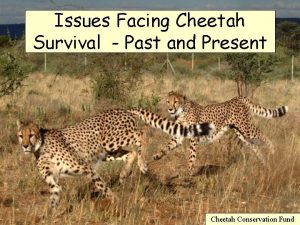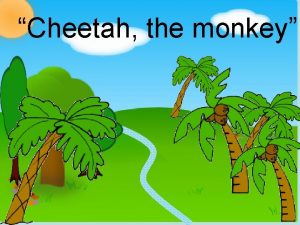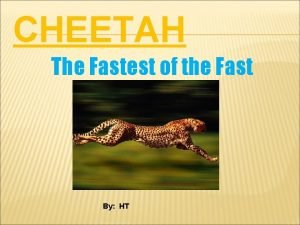Animals Cheetah The cheetah is the worlds fastest










- Slides: 10

Animals

Cheetah The cheetah is the world's fastest land mammal. With acceleration that would leave most automobiles in the dust, a cheetah can go from 0 to 60 miles (96 kilometers) an hour in only three seconds. These big cats are quite nimble at high speed and can make quick and sudden turns in pursuit of prey.

snakes Snakes are carnivores (meat eaters). Snakes don’t have eyelids. Snakes can’t bite food so have to swallow it whole. Snakes have flexible jaws which allow them to eat prey bigger than their head! Snakes are found on every continent of the world except Antarctica. Snakes have internal ears but not external ones. Snakes used in snake charming performances respond to movement, not sound. There around 3000 different species of snake. Snakes have a unique anatomy which allows them to swallow and digest large prey. Snakes are covered in scales. Snakeskin is smooth and dry. Snakes shed their skin a number of times a year in a process that usually lasts a few days.

Sea Turtles Archie Carr's writings inspired generations of students and conservationists to research these animals and to work for their protection. Over this period, we have learned a great deal about sea turtles and made huge strides towards building the knowledge base necessary to form effective conservation strategies.

bears The largest mammalian carnivore that ever lived on land was the giant short-faced bear. Twice the size of the biggest modern bear, it was 6 5 tall at the shoulder when standing on all fours. Scientists believe it had very long legs and chased antelope on the North American prairies. It died around 12, 000 years ago. The sloth bear has the shaggiest fur. The sun bear has the shortest fur so it can keep cool in the hot forests of Southeast Asia.

bats Some Mexican free-tailed bats can fly up to 250 miles (402 km) in a single night. They can fly up to 10, 000 feet (3, 048 m) high and reach speeds up to 60 miles per hour (97 kph). A small colony of bats can eat over one ton of insects in one year, or more than 600 million bugs. A single bat can eat more than 600 bugs in one hour, which is like a person eating 20 pizzas a night.

Penguins are one of about 40 species of flightless birds. Other flightless birds include rheas, cassowaries, kiwis, ostriches, and emus. Most flightless birds live in the Southern Hemisphere. Most scientists agree that there are 17 species of penguins. Of the 17 species, 13 are either threatened or endangered, with some on the brink of extinction.

Jellyfish are found in every ocean of the world. They are even found in some freshwater lakes and ponds. Jellyfish range from the size of a thimble or the eraser tip of pencil to approximately 8 feet in diameter and tentacles that reach 200 feet. That is as long as two blue whales.

monkeys A monkey is any primate that is not a human, prosimian or ape. Monkeys have tails, but apes do not Monkeys are most easily distinguished from apes by their tails. Apes have no tails. Apes and spider monkeys swing arm-to-arm in trees, but most monkeys don’t. Instead, they run across branches. A monkey is any primate that is not a human, prosimian, or ape. Monkeys have tails, but apes do not Monkeys are most easily distinguished from apes by their tails. Apes have no tails. Apes and spider monkeys swing arm-to-arm in trees, but most monkeys don’t. Instead, they run across branches.

THE END Thanks for watching my power point I hope you liked it By JJ if you are on animal jam my username is cheetah 18 jake
 Oranges contain both calcium and vitamin c. fact or opinion
Oranges contain both calcium and vitamin c. fact or opinion Costly degrees of comparison
Costly degrees of comparison Cheetah's cheetah life cycle
Cheetah's cheetah life cycle Worlds together worlds apart 4th edition
Worlds together worlds apart 4th edition Animals that eat both plants and animals
Animals that eat both plants and animals Https://a-z-animals.com/
Https://a-z-animals.com/ Animals that eat both plants and animals
Animals that eat both plants and animals Parasitic food chain
Parasitic food chain Ecotourism is one of the fastest
Ecotourism is one of the fastest Sound travels fastest through
Sound travels fastest through Normal fault
Normal fault



















